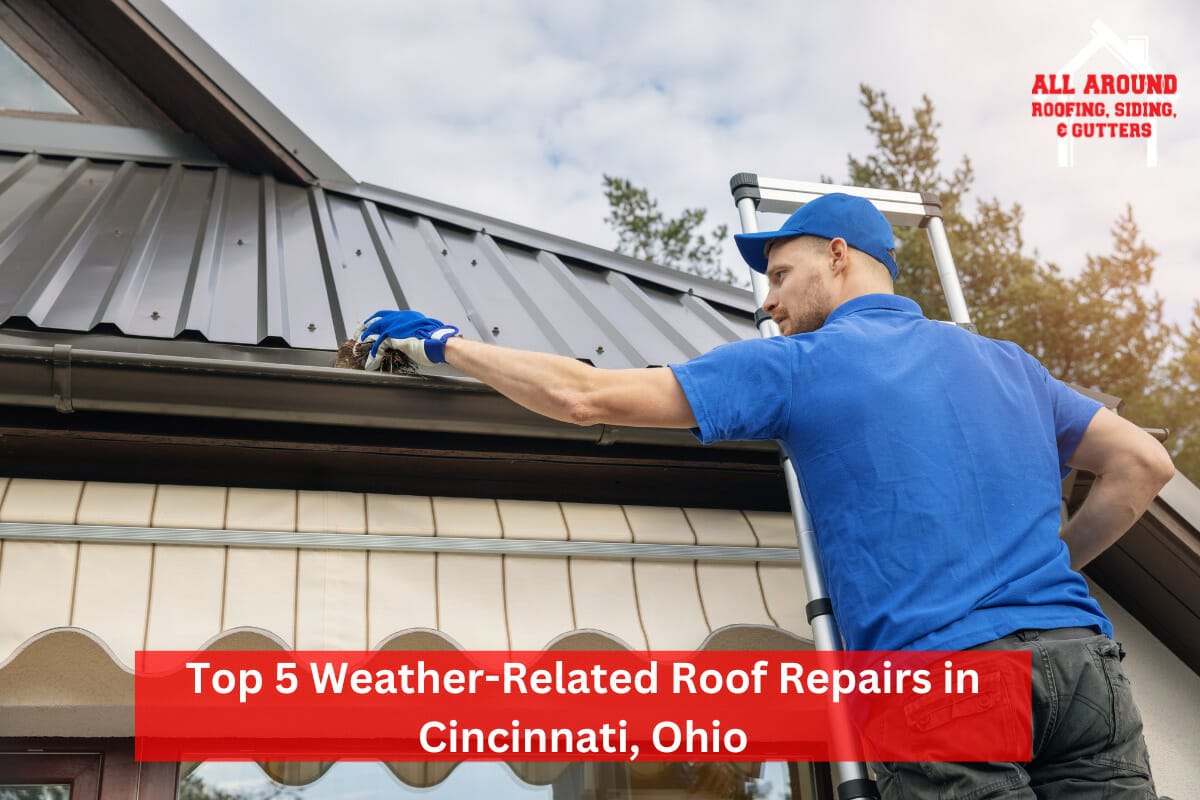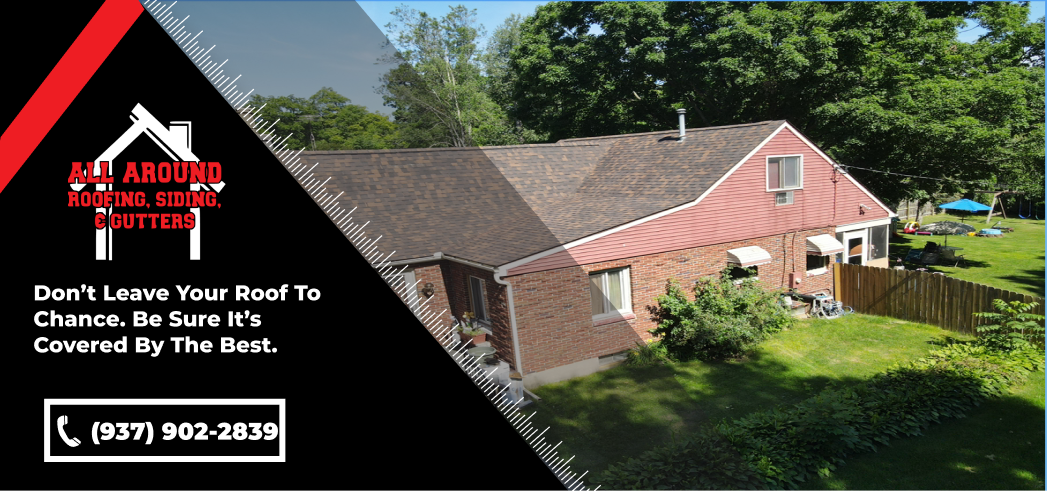Do you own a home or a property in Cincinnati and are concerned about the state of your roof? If so, you’re not alone. The weather in Cincinnati can be unpredictable and severe, which can take a toll on your roof over time. In this blog post, we have covered five weather-related roof repairs in Cincinnati to help you decide before it’s too late.
Frequent Weather Events in Cincinnati, Ohio
Cincinnati, Ohio, is known for its diverse and often unpredictable weather, ranging from mild to extreme conditions. While these weather events can be exciting, they also raise concerns for homeowners. Different roof types react differently to different weather conditions. High winds, severe storms, and hail all cause damage to roofs, often necessitating weather-related roof repairs.
#1. Snow and Ice Buildup
A common issue in Cincinnati is snow and ice buildup. Due to snowy winters, roofs in Cincinnati bear a considerable amount of weight from accumulated snow. This can be worrisome, especially if your roof is old, and it will likely lead to a need for roof damage repair.
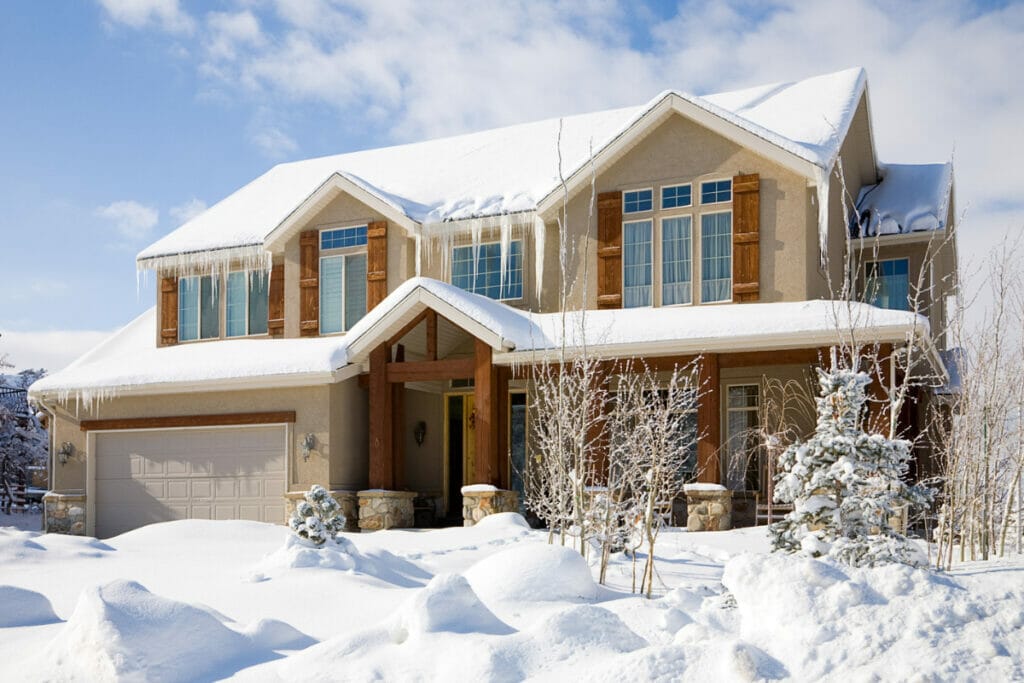
Damage Caused by Snow and Ice Buildup
1. Roof Leaks
Temperature fluctuations can cause snow on a roof to melt, and if there’s no adequate drainage system it can lead to ponding water, a common cause of roof leaks. Prolonged ponding water is detrimental to the roof’s structural integrity, roofing materials, and the interior of the home.
2. Structural Damage
If snow that’s built up on the roof melts and refreezes along the edge of the roof due to temperature changes along the roof’s surface, it will create what’s known as an ice dam. The added weight of ice dams around the roof’s edge causes it to sag, crack and occasionally collapse. This harms the integrity of your roof by causing structural damage.
3. Damage To Gutters
As snow accumulates on the roof, the added weight puts pressure on the gutter system. This additional weight can cause gutters to bend, warp, or detach from the roof. If ice dams have formed, they also have the potential to tear down the gutter system.
How To Repair Roofs Damaged by Snow and Ice
- First, removing any remaining snow or ice from the roof is important to prevent further damage.
- Once the roof is clear, the next step is to inspect the roofing materials for wind and storm damage.
- If there are any leaks, place a bucket under them to catch the water so it does not cause further damage to the interior of your home.
- Repairing roofs involves replacing missing or broken shingles or repairing cracks and leaks with roofing cement. If gutters or downspouts are damaged, they should also be repaired or replaced as needed.
#2 High Winds
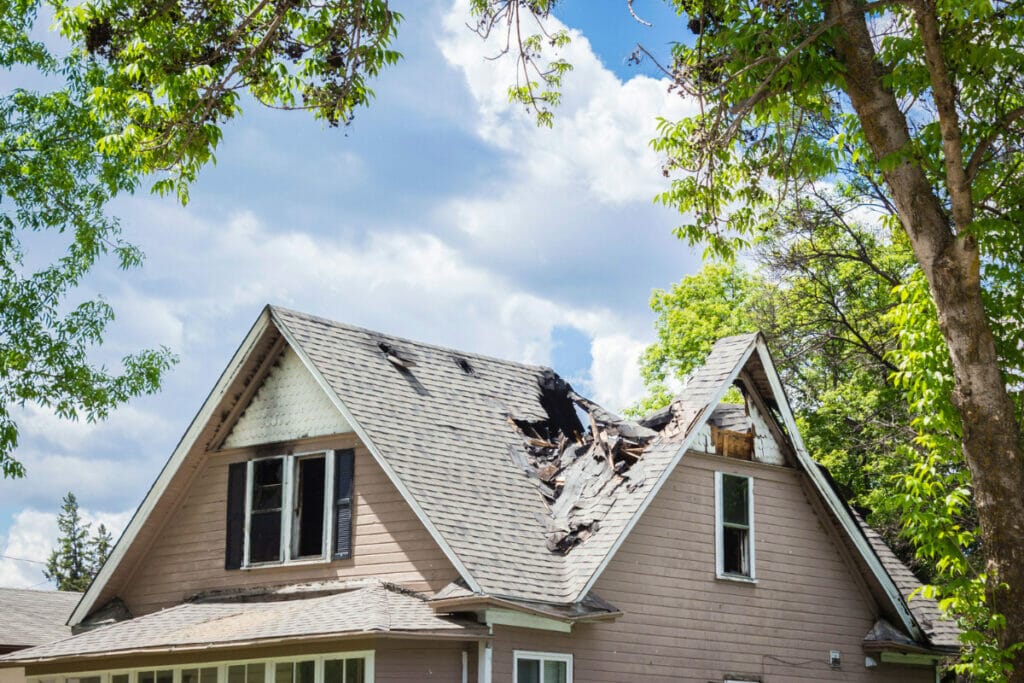
High winds are the root cause of missing and broken shingles, or tiles, on a roof. In addition, the broken and missing shingles allow wind-driven rain to seep into your roof deck, causing the roofing structure to rot and become damaged.
Damage Caused by High Winds
Wind damage to a roof looks like this:
1. Missing or Damaged Shingles
One of the reasons for missing or broken shingles is high winds. Wind lifts up the shingles, causing them to crack, or tear them off completely. This creates gaps where water can get through.
2. Skylight, Vents, and Gutter Damage
Skylights and vents are particularly vulnerable as they are typically made of glass or plastic, which can crack or shatter upon the impact of wind-driven debris. Similarly, gutters and downspouts can be damaged by flying debris or by the force of the wind itself.
How To Repair Roofs Damaged by High Winds
- You must clear any debris or fallen branches away from the area to prevent further damage from wind-driven debris.
- If the roof has sustained damage, replace any missing or broken shingles, and repair water damage.
- Check the skylights, vents, gutters, and windows that are damaged and repair them with the help of a professional contractor.
#3 Heavy Rains
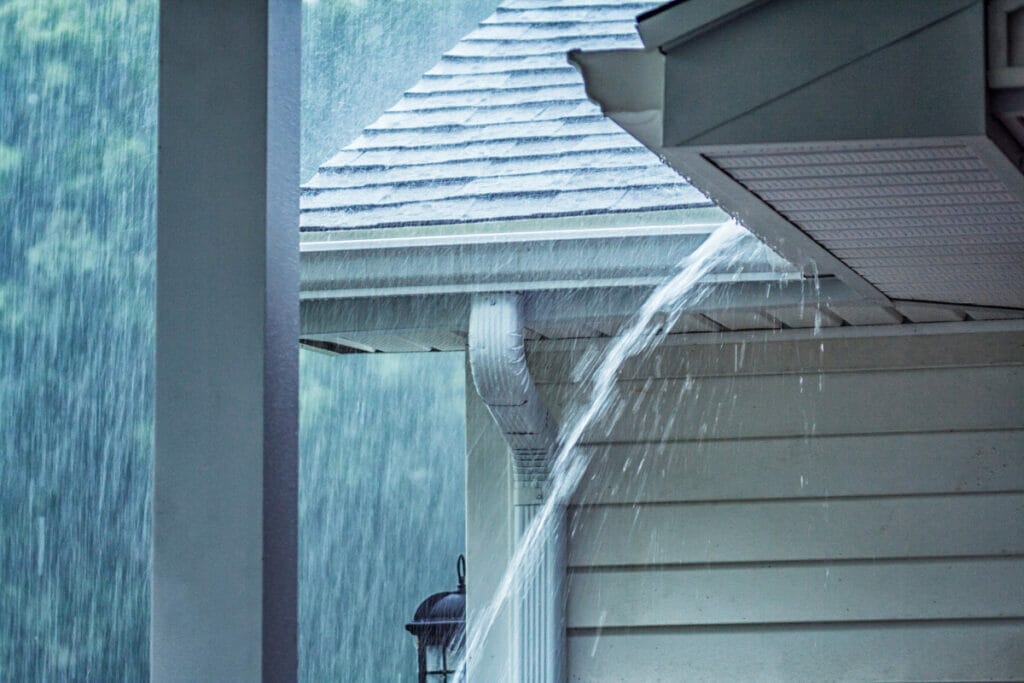
Water pooling on the roof from heavy rains is a major cause of roof leaks, but the damage can also manifest in various ways.
Damage Caused by Heavy Rain
1. Ponding Water and Leaks
When it rains heavily, water can accumulate on the roof’s surface faster than it can drain away, especially if the roof has a low slope or if there are drainage issues. Debris, such as leaves or branches, can also block gutters and downspouts, preventing proper drainage of water from the roof.
2. Mold and Mildew
When water accumulates on the roof’s surface due to heavy rain or ponding water, it can seep into any cracks or crevices and get trapped under shingles or in other areas of the roof. This trapped water can create a moist and humid environment, which is ideal for the growth of mold and mildew.
3. Damage to the Roofing Material and Gutters
Roofing materials and gutters are also prone to damage due to heavy rain, as they handle a significant amount of water during that time. The high volume of water that passes through gutters can also potentially damage ones that were poorly installed.
How to Repair Roofs Damaged by Heavy Rain
- Clear any debris or standing water from the roof to prevent further damage.
- Repair any damage found during an inspection. This may include replacing missing or broken shingles, fixing leaks, or patching cracks.
- Repair or replace any damaged gutters or downspouts to ensure proper drainage from the roof.
- Look for any signs of mold or mildew growth on the roof, and clean and treat it as necessary to prevent further growth.
- If the damage is extensive or you are not comfortable with the repair process, consider hiring a professional roofing contractor to make the repairs.
#4 Hail Damage
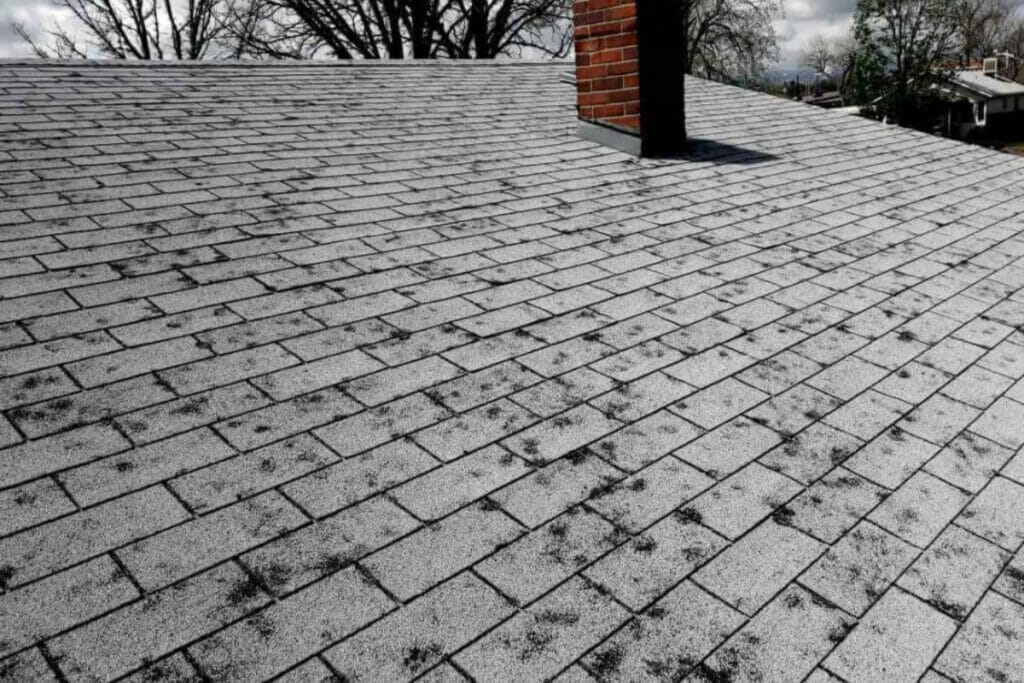
Hailstones can range in size from small pebbles to large chunks of ice, and their impact can cause cracks, dents, and other forms of damage to roofing materials. In many cases, hail damage may not be immediately apparent, but may appear over time as leaks or other issues arise.
Damaged Caused by Hail
1. Granule Loss
When hailstones hit shingles, they can dislodge granules from the shingle surface by chipping them off or loosening them enough to be washed away by rain. This sign of damage is visible and can be observed when the roof is dry.
2. Fractures on Shingles and Tiles
Shingles are particularly vulnerable to damage from hailstones because they are often made of asphalt and fiberglass, which can be brittle and prone to cracking under impact. Hailstones can also cause tiles to crack or break, which can compromise the integrity of the roof and allow moisture to seep into the roof deck.
3. Damaged Skylights and Gutters
Skylights and gutters are also susceptible to hail damage. The gutter system, and especially skylights, may crack due to the forceful impact of hails falling on them. They may crack the pane of a skylight if the hailstone is large enough, causing water to leak into a home.
How to Repair Roofs Damaged by Hail
- Inspect the roof to assess the extent of the damage. Look for cracks, dents, missing or broken shingles, granule loss, and other signs of damage.
- Document the damage with photos and notes to create a report for an insurance claim if you plan to file a claim for storm damage.
- It’s best to hire a roofing professional to determine the best course of action for repairing the damage. This may involve replacing damaged shingles and repairing or replacing gutters or skylights.
#5 Temperature Extremes
Temperature extremes can cause significant damage to roofs in Cincinnati and other areas with similar climates. Here are some ways in which temperature can damage roofs:
Damage Caused by Temperature Variance
1. Thermal Expansion and Contraction
Roofing materials, such as asphalt shingles and metal sheets, are more prone to undergo thermal expansion and contraction caused by fluctuations in temperature. The expansion and contraction of a roof with respect to changes in temperature cause roofing materials to warp, crack, and shift.
2. Color Fading and Deterioration
The direct exposure of roofs to UV rays coming from the sun causes the color of roofing materials to fade. UV exposure also decreases the lifespan of roofs by accelerating their aging.
How to Repair Roofs Damaged by Temperature Variance
- Protect the roof from UV damage by applying a UV-resistant coating or paint to your roofing materials, particularly metal.
- Enhance the roof and attic ventilation and insulation systems to regulate temperature and reduce the impact of temperature fluctuations.
- If you’re unsure about the extent of the damage or the best course of action, consult a professional roofing contractor for expert guidance and repairs.
Are You Facing Roof Damage Due To the Weather in Cincinnati, Ohio?
Do you have weather-related damage on your roof? If yes, then any delay in repairing them can further damage your roof and cause you to pay more money. Therefore, Call All Around Roofing, Siding & Gutters at (937) 902-2839 for consultation with one of our experts. Our team is experienced in handling all types of roofing projects in Cincinnati, including roof repairs, replacement, and installation.

